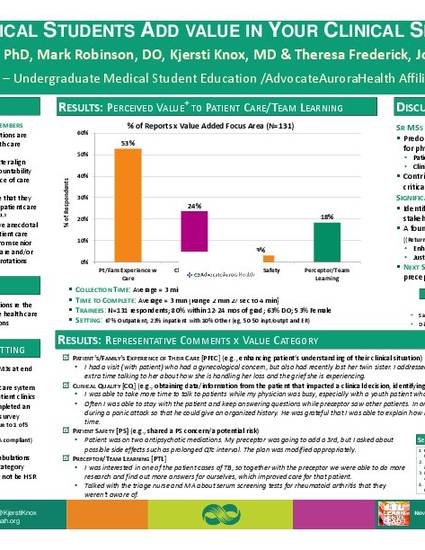
Background: First- and second-year medical students perceive that they can make meaningful contributions to patient care and/or the health care team’s learning. However, there is limited formal data from more senior medical students regarding the value they add to patient care and/or the team during their late-second through fourth year-required clinical rotations.
Purpose: To obtain and codify senior medical students’ perceptions regarding the value they add to patient care and/or the health care team during their required clinical rotations.
Methods: Senior medical students at end of required clinical rotations voluntarily completed an online, anonymous 5-item “value added to clinical care” survey. Medical students checked if they added value to 1 of 5 literature-derived categories and then were asked to describe the situation in HIPAA-compliant format. Analysis included frequency tabulations by value-added category and qualitative analysis of narrative examples by category.
Results: There were 131 respondents (53% women), 80% of whom were within 12–24 months of graduation. In all, 67% of valuedadded contributions occurred in the outpatient setting, 23% in the inpatient setting, and 10% in other settings (eg, 50/50 inpatient/ outpatient and emergency department). More than half of reports (53%) focused on the category Patient’s/Family’s Experience of Their Care (eg, enhancing patient’s understanding of their clinical situation). For example, “I had a visit (with patient) who had a gynecological concern but also had recently lost her twin sister. I addressed her chief complaint but then spent some extra time talking to her about how she is handling her loss and the grief she is experiencing.” In other categories, 24% focused on added value to Clinical Quality (eg, obtaining data/information from the patient that impacted a clinical decision, identifying alternative approaches), 18% on Preceptor/Team Learning, and 3% of students reported Patient Safety-related valued-added situations. (eg, shared a patient safety concern/a potential risk).
Conclusion: Identifying the value added by students allows educators to identify assets and potential opportunities (like patient safety) to enhance student roles in clinical care. It also provides rich data for educational leaders’ use with key clinical/community stakeholders regarding how medical student education adds value to patient care and the health care team.
Simpson D, Robinson M, Knox K, Frederick T, Brill JR. Medical students add value in your clinical setting. Poster presented at: Aurora Scientific Day; May 20, 2020; virtual webinar hosted in Milwaukee, WI.

Academic Affairs – Undergraduate Medical Student Education
Advocate Aurora Health affiliated with UWSMPH